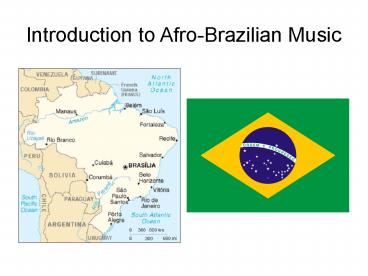Introduction to Afro-Brazilian Music - PowerPoint PPT Presentation
Title:
Introduction to Afro-Brazilian Music
Description:
Other ethnicities: Italian, Spanish, German, Polish, Japanese, Syrian/Lebanese ... Brincar = verbal play (improvised song lyrics with stock refrains) ... – PowerPoint PPT presentation
Number of Views:111
Avg rating:3.0/5.0
Title: Introduction to Afro-Brazilian Music
1
Introduction to Afro-Brazilian Music
2
Cultural/Ethnic Influences
- Indigenous peoples
- Including Guarani, Tupi, Kayapo, Yanomami
- Portuguese (European)
- Other ethnicities Italian, Spanish, German,
Polish, Japanese, Syrian/Lebanese - African (mostly West-African)
- Including Bantu, Yoruba, Ewe
3
Slave Trade
- 1538-1850 approx. 3.5 million slaves from Ghana,
Nigeria, Angola, Congo, Mozambique (incl.Yoruba,
Ewe, Fon). - 1850 slave trade abolished
- 1871 Law of the Free Womb
- 1888 Slavery abolished
4
General Characteristics of West
African/Afro-Brazilian Music
- Dense textures
- Interlock
- Rhythmic complexity (polyrhythm)
- Open-ended forms
- Structure based on melodic/rhythmic ostinato
patterns - Music is means of communal participation
5
Candomblé
6
Aspects of Candomblé
- Afro-Brazilian religion (syncretic)
- Worship of hierarchy of orixás deities
- Ceremonies involves dancing, drumming, singing
(in Yoruban), to invite orixás to manifest
(spirit possession)
7
The Orixás
- Olorun (creator of the universe, sky father)
- Exú (gatekeeper trickster god)
- Xango (warrior, god of thunder, fire)
- Iemenjá (goddess of sea mother goddess)
- Orixas are related to each other
- Each has preferred foods, colors, symbols
- Each has distinct personality
8
Musical Characteristics of Candomblé
- Musical characteristics
- Call and response
- Polyrhythms
- Open-ended forms
- Specific rhythms for each orixá
- Hierarchy of drums
9
Instruments Used in Candomblé
- Atabaque drums (set of three Rum, Rum-Pi, Lê)
- Agogô (double-headed cowbell)
- Drums considered sacred instruments must be
baptised before use
10
Candomblé Drumming
- Three drums are in hierarchical relationship
directed by master drummer - Master drummer oldest male initiate, lead
singer, plays any drum he desires responsible
for facilitating spirit possession - Plays improvised patterns against rhythmic
ostinato patterns of other drums
11
Capoeira
Afro-Brazilian art form combining music, dance
and martial arts
12
Capoeira
- Instruments
- Berimbau musical bow with shaker
- Pandeiro similar to tambourine, played with
hands - Atabaque drums similar to conga drums, played
with hands - Agógô double-headed cowbell, struck with stick
13
Roda de Capoeira
- Jogar body play
- Ginga basic movement
- Tocar musical play
- Lead berimbau plays toques (rhythmic patterns)
- Directs course of the game
- Brincar verbal play (improvised song lyrics
with stock refrains) - Malíciacunning, trickery (ex. Benção)































